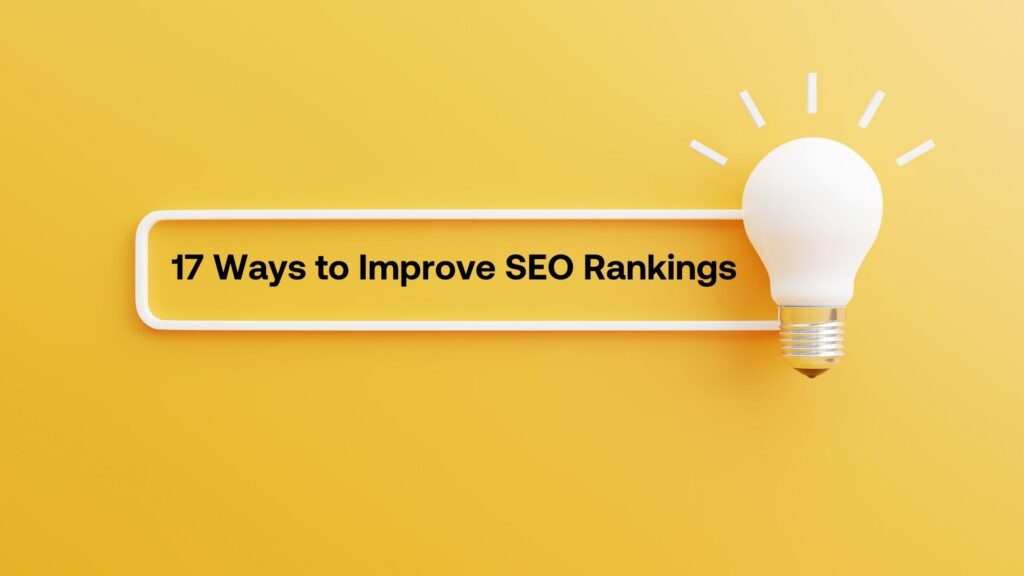17 Proven Ways to Boost Your SEO Rankings
Want to dramatically improve your SEO rankings this year? You’re in the right place. In this comprehensive guide, I’ll reveal 17 actionable strategies you can use to climb the search engine results pages (SERPs) and drive more organic traffic to your website.
As an SEO expert at IncRev, I’ve tested and refined these techniques to help our clients achieve outstanding results. In fact, implementing just a handful of these strategies helped grow our organic traffic by over 28% in the past year alone.
So if you’re looking for proven ways to boost your Google rankings and organic search visibility, you’ll love the actionable tips in this guide. Let’s dive in!
1. Optimize Your Site Speed
Page load time has a direct impact on your search rankings. Google has confirmed that site speed is a ranking factor, especially for mobile searches. Our research shows that pages ranking at the top of the first page tend to load significantly faster than those lower down.
To check your current site speed, use tools like:
Some quick ways to improve site speed include:
- Compressing images
- Upgrading to a faster web host
- Minifying CSS, JavaScript, and HTML
- Leveraging browser caching
- Using a content delivery network (CDN)
Even small improvements in load time can have a big impact on rankings and user experience.
2. Optimize for Featured Snippets
Featured snippets are the highlighted search results that appear at the top of Google’s organic results. Ranking in the featured snippet can significantly boost your organic click-through rate.
To optimize for featured snippets:
- Identify keywords you already rank on page 1 for
- Analyze the current featured snippet
- Create content specifically designed to match the snippet format (definition, list, table, etc.)
3. Improve Dwell Time
Dwell time – how long visitors stay on your page before returning to the search results – is an important quality signal for Google. A low dwell time suggests your content isn’t satisfying searchers.
One of the best ways to increase dwell time is by embedding relevant videos in your content. Our testing shows pages with embedded videos have an 11.2% lower bounce rate on average.
Aim to include videos that:
- Further explain key concepts
- Demonstrate processes step-by-step
- Showcase product features
4. Earn Sitelinks
Sitelinks are the additional links that sometimes appear under a search result, allowing users to jump directly to specific sections of your site. They can significantly boost your organic click-through rate.
To increase your chances of earning sitelinks:
- Add a clear, logical site structure
- Use descriptive internal anchor text
- Create a detailed XML sitemap
- Add schema markup to key pages
We’ve found adding a table of contents with jump links is particularly effective for earning sitelinks on long-form content.
5. Create Linkable Assets
Not all content is equally link-worthy. To attract high-quality backlinks naturally, focus on creating linkable assets like:
- Original research and data
- Comprehensive guides and tutorials
- Infographics and other visual content
- Free tools and calculators
For example, our voice search study has earned over 1,200 backlinks from authoritative sites – far more than our typical blog posts.
6. Target High Commercial Intent Keywords
While search volume is important, don’t neglect commercial intent. Keywords with high cost-per-click (CPC) in Google Ads often indicate strong buyer intent.
For example, “link building services” has a much lower search volume than “link building,” but the traffic is far more valuable.
Targeting these buyer-focused keywords can lead to higher conversion rates and ROI from your SEO efforts.
7. Optimize Video Content
YouTube videos often rank well in Google search results. Creating and optimizing video content gives you another opportunity to appear for your target keywords.
Key video optimization tips:
- Use your target keyword in the video title, description and tags
- Create an engaging custom thumbnail
- Add closed captions and transcripts
- Embed the video on a relevant page on your site
8. Create “Topic + Statistics” Pages
Pages that compile key statistics on popular topics tend to attract a lot of backlinks naturally. Journalists and bloggers are constantly looking for credible data sources to cite.
To create link-worthy statistics pages:
- Choose a popular topic in your industry
- Gather statistics from authoritative sources
- Present the data in an easy-to-reference format
- Update the page regularly with fresh stats
9. Align Content with Search Intent
One of the most common reasons for rankings drops is misalignment with search intent. As Google gets better at understanding user intent, it’s crucial that your content matches what searchers are actually looking for.
To optimize for search intent:
- Analyze the current top-ranking pages
- Identify the dominant content types (guides, product pages, etc.)
- Ensure your page matches user expectations
- Address common questions and pain points
10. Pursue Content Partnerships
Collaborating with other brands and influencers in your industry can significantly amplify your content’s reach and link-earning potential.
Some effective content partnership ideas:
- Co-author research studies
- Create joint webinars
- Develop multi-brand resources
- Cross-promote on social media
11. Repurpose Existing Content
Don’t let your best content ideas live in only one format. Repurposing allows you to reach new audiences and reinforce your message across channels.
Try repurposing content into:
- Blog posts from videos
- Infographics from statistics
- Podcasts from articles
- Social media posts from key takeaways
12. Use Broken Link Building
Broken link building involves finding broken links on other sites and suggesting your content as a replacement. It’s an effective way to earn contextual backlinks.
The process:
- Find relevant broken links using tools like Ahrefs
- Create or identify a suitable replacement resource
- Reach out to the site owner with your suggestion
13. Analyze Competitor Backlinks
Use tools like Semrush’s Backlink Gap to identify sites that link to multiple competitors but not to you. These represent prime link building opportunities.
14. Target Emerging Keywords
New topics and trends often have lower competition. By targeting emerging keywords early, you can often rank more easily and establish topical authority.
Use tools like Google Trends and BuzzSumo to identify rising topics in your industry.
15. Create Concept Visuals
Original diagrams, charts and other visual aids that explain complex concepts are highly shareable and link-worthy. Create custom visuals to illustrate key ideas in your content.
16. Leverage Industry Glossaries
Industry-specific glossaries can be goldmines for keyword ideas. Use them to:
- Identify niche-specific terms
- Find related concepts to cover
- Generate long-tail keyword variations
17. Connect with Content Curators
Build relationships with industry curators who compile “best of” content roundups. Getting featured in these curated lists can drive traffic and earn valuable backlinks.
Bonus Tips
Find Question Keywords
Use tools like AnswerThePublic and QuestionDB to identify common questions in your niche. These make great topics for FAQ pages and blog posts.
Target Brand Keywords
Creating content around popular brand names in your industry can tap into high-volume searches with relatively low competition.
Conclusion
Implementing even a few of these proven SEO strategies can have a significant impact on your organic search visibility. Remember that SEO is an ongoing process – continually test, refine and adapt your approach based on results.
Need help executing these tactics? The SEO experts at IncRev can develop a customized strategy to boost your rankings and drive more qualified organic traffic. Contact us today for a free consultation.
Frequently Asked Questions
How long does it take to see results from SEO?
SEO is a long-term strategy, but you can start seeing initial improvements within 3-6 months. Significant results typically take 6-12 months or more, depending on your niche and competition.
What’s the most important ranking factor?
There’s no single most important factor. Google uses hundreds of signals. Focus on creating high-quality content, earning authoritative backlinks, and providing a great user experience.
Is it possible to rank without backlinks?
It’s possible but difficult, especially for competitive keywords. While content quality is crucial, backlinks remain an important trust signal for Google.
How often should I publish new content?
Quality matters more than quantity. Focus on publishing well-researched, in-depth content consistently, even if that’s only 1-2 times per month.
What’s the ideal word count for SEO?
There’s no universal ideal length. Aim to comprehensively cover the topic and satisfy user intent. For most topics, 1,500-2,500 words is a good target range.


